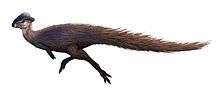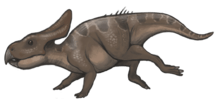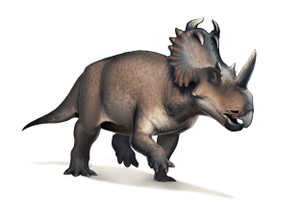Dysganus
Dysganus (dis-GANN-us) (meaning "rough enamel") is a dubious genus of ceratopsian dinosaur from the Campanian stage of the Late Cretaceous. Its fossil teeth were discovered by Edward Drinker Cope in the Judith River Formation in Montana.[1]
| Dysganus | |
|---|---|
| Scientific classification | |
| Kingdom: | Animalia |
| Phylum: | Chordata |
| Clade: | Dinosauria |
| Order: | †Ornithischia |
| Parvorder: | †Coronosauria |
| Superfamily: | †Ceratopsoidea |
| Family: | †Ceratopsidae |
| Genus: | †Dysganus Cope, 1876 |
| Type species | |
| †Dysganus encaustus (Cope, 1876) | |
| Species | |
| |
History
Four species have been assigned to Dysganus: D. encaustus, D. bicarinatus, D. peiganus and D. haydenianus. All are based solely on teeth and were described by Edward Drinker Cope in 1876.[1] In 1907, John Bell Hatcher redescribed the teeth of Dysganus, and found that the genus was a nomen dubium. The teeth of D. peiganus were thought to be from a stegosaurian by Lull and Wright in 1942.[2]
The type specimens of each species consist of one to eight teeth, all being detached.
Classification
Cope originally classified Dysganus in Trachodontidae, a family of hadrosauroids now considered a junior synonym of the family Hadrosauridae.[3] In 1901, Franz Nopcsa von Felső-Szilvás assigned Dysganus to the Ceratopsia, either by reading Cope's original descriptions of the genus, or by Cope in 1890 indirectly suggesting that Dysganus was a ceratopsian rather than a "trachodontid". Later in 1907, Hatcher et al. republished Cope's original descriptions of Dysganus in their entirety and deduced that the holotype of D. encaustus included teeth of hadrosaurids (then trachodontids), and the teeth of ceratopsids[4].
Paleoecology
All 4 species are known from the Judith River Formation. It lived alongside the dubious dinosaur genera Palaeoscincus, Ceratops, Cionodon, Diclonius, Pteropelyx, Zapsalis, Deinodon, Aublysodon, Trachodon and Monoclonius.[5]
References
- E. D. Cope. 1876. Descriptions of some vertebrate remains from the Fort Union Beds of Montana. Proceedings of the Academy of Natural Sciences of Philadelphia 28:248-261.
- Lull, R.S. & Wright, N.E. (1942). "Hadrosaurian Dinosaurs of North America". Geological Society of America Special Papers. 40: 27–28.
- Stanton, T.W.; Hatcher, J.B.; Knowlton, F.H. (1905). Walcott, C.D. (ed.). "Geology and Paleontology of the Judith River Beds: With a Chapter on Fossil Plants". United States Geological Survey Bulletin. 8 (157): 90.
- Coombs, Walter P., and Peter M. Galton. “Dysganus, an Indeterminate Ceratopsian Dinosaur.” Journal of Paleontology, vol. 62, no. 5, 1988, pp. 818–821. JSTOR, JSTOR, www.jstor.org/stable/1305404.
- Cope, E.D. (1879). Hayden, F.V. (ed.). "The Relations of the Horizons of Extinct Vertebrata". United States Geological and Geographical Survey. 5 (1): 37–38.


